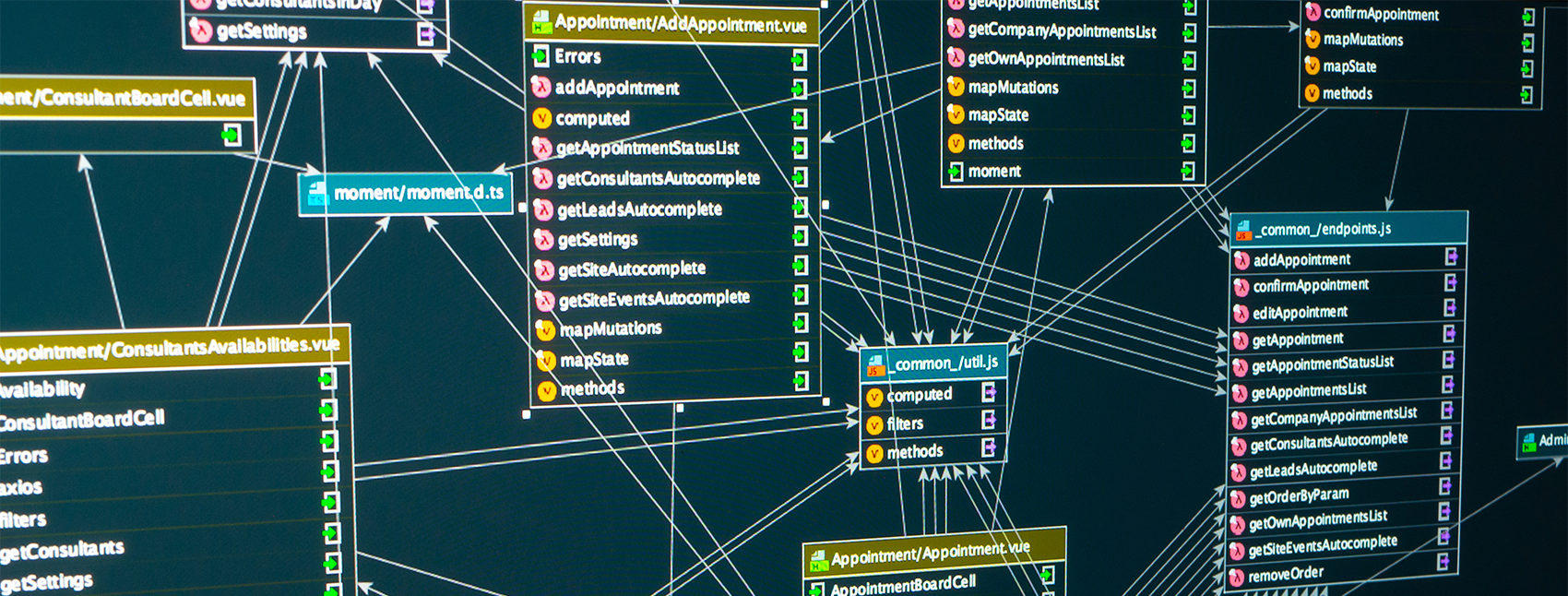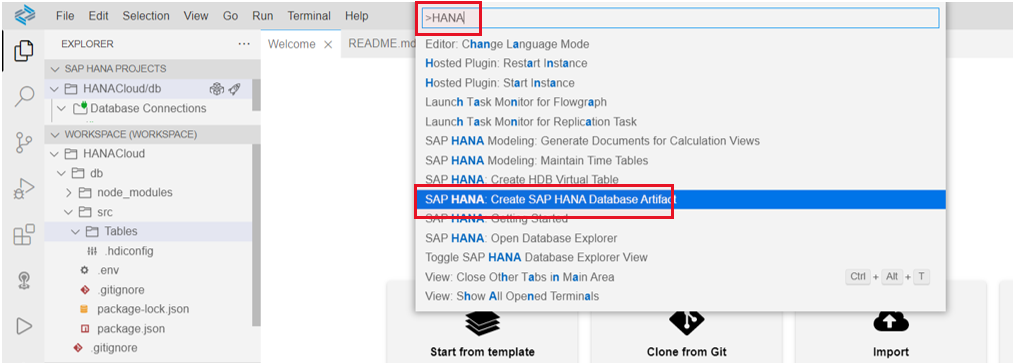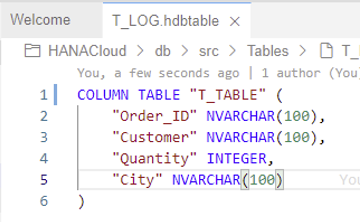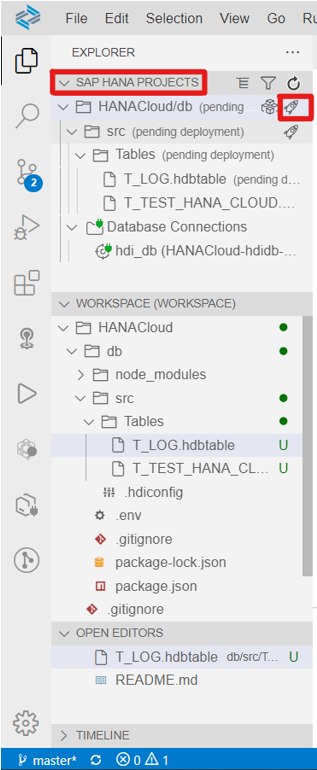Welcome to the second installment in our six-part series of user guides to SAP HANA. If you haven’t yet read the first article: SAP HANA Cloud Series Parte 1: cómo configurar el entorno —we’d recommend you go back and take a look before continuing. There’s a lot of useful introductory information that you won’t want to miss out on.
En este artículo, nuestros objetivos principales son definir las estructuras y los roles de las tablas, y luego exploraremos cómo importar datos al espacio de desarrollo que explicamos cómo crear en la Parte 1.
1. Crear una tabla
The first thing to point out is the different types of tables available in SAP HANA Cloud: ‘.hdbtable’ and ‘.hdbmigrationtable’.
The first, ‘.hdbtable’ makes an internal copy—which can increase the cost, as when a table is changed and deployed, the software performs the migration statements that are missing for the new version.
The last one, ‘.hdbmigrationtable’ uses explicit versioning and migration tasks. The modifications to the database are specified in the design file and carried out on the database table exactly as specified.
NB: A los efectos de esta serie de guías, utilizaremos ".hdbtable" en todo momento.
Entonces, comencemos creando una tabla. En primer lugar, crearemos una carpeta para contener las tablas; para esto, vaya a SAP Business Application Studio, haga clic con el botón derecho en la carpeta 'src' en la sección de su Área de trabajo y cree una nueva carpeta.
The next step is to create the table itself. Press F1, type ‘HANA’ and select the option ‘SAP HANA: Create SAP HANA Database Artifact’ as shown below:
When you click on the option mentioned, the creation wizard will be opened. Specify the new folder you created previously as a source, the artifact type (which in our case is ‘Table’, but you can select ‘Migration Table’ if you prefer) and finally enter the name of the table, as in the screenshot here:
2. Definir la estructura de la tabla
Una vez que la tabla se haya creado correctamente, estará disponible en el explorador (en el lado izquierdo del panel SAP BAS). Haga doble clic en el nombre de la tabla para abrir la definición. Como la tabla se acaba de crear, deberá definir la estructura de la tabla, por ejemplo:
Note that in this case the table was defined as a column table. SAP HANA is optimized for column storage—achieving high-performing read operations while also maintaining good performance for write operations. In addition, some features are only available for column tables.
Once the definition is complete, you can move on to deploying the project. To do this, go to the SAP HANA PROJECTS tab and click, the rocket icon (🚀):
At this point, we’ve seen how to create tables, but please note that by following similar steps it is also possible to create any other Artifact available in SAP HANA Cloud such as calculation views, analytic privileges, flow graphs, etc.
3. Importar Datos
Ahora que nuestra tabla ha sido creada y hemos definido correctamente la estructura, es hora de llenarla con los datos que necesitamos. Para hacerlo, navegue a SAP Business Application Studio y abra el contenedor HDI:
An HDI container is a service layer of the SAP HANA Database that manages dependencies, executes as a transaction, and consists of schemata and a set of users that together allow an isolated deployment of database artifacts.
When the SAP HANA Database Explorer is open, you can now expand the drop-down list of artifacts contained in the HDI. Notice that they are grouped by type, and so the table we created before should be under the ‘Tables’ category. Click on that category.
In the list shown below, right-click the table name and select ‘Import Data’, as shown here:
When you click on ‘Import Data’, the wizard will be open automatically. Select the ‘Import Data’ radio button and then click on ‘Step 2’. In the second step, you must select the source file (note that it can be a local file on your computer or cloud storage). Whatever file you import, make sure that it is in the comma separated value or ‘.csv’ format. Select the option you prefer, insert the file and click on the ‘Step 3’ button.
Here, enter the destination table name and click the ‘Step 4’ button. This is the most important step, as you need to correctly map the columns in your ‘.csv’ file with the columns defined in the table definition process. Make sure that both data types match and click on ‘Step 5’. Select the option you prefer and click on ‘Import Into Database’ in the review menu:
NB: El proceso mencionado anteriormente es solo una de las opciones para importar datos a las tablas. La alternativa es importar datos manualmente usando una instrucción INSERT SQL. Esto solo es posible si los permisos de la tabla están definidos correctamente. La definición de estos permisos se explicará en la siguiente sección.
4. Crear HDBROLES
An HDBROLE is the way that SAP HANA groups the different privileges to perform database activities. Defining these roles correctly is a critical part of the system administrator’s responsibilities—in order to control access to and modification of the SAP HANA database objects.
The first step to defining these roles is to create a folder under the src folder where all the roles will be contained. Press F1 and ‘SAP HANA: Create SAP HANA Database Artifact’. In the creation menu select ‘Role (hdbrole)’ and configure the other fields as in the table creation section. Make sure to finish the role name with a ‘#’ character—this is compulsory for all role definitions.
En el menú de definición, seleccione la pestaña de Object Privileges (ya que estará vinculada a la tabla que se ha creado en las secciones anteriores), verifique que el nombre del rol esté en el formato correcto y seleccione las tablas que desea aplicar para este rol y sus privilegios. Por último, vuelve a desplegarel proyecto haciendo clic en el icono del cohete:
NB: There is another way to define the role, although it is less intuitive. By definition, the roles follow the JSON syntax, so it is possible to define it as a JSON file. If you prefer this option, open the role definition by right-clicking the ‘.hdbrole’ file of your workspace and Open With… > Code Editor. The definition described above translated to JSON syntax will look like the following:
That brings us to the end of this installment in the SAP HANA series. We hope you’ve found it a useful guide to the process of setting up, defining and populating tables. Look out for parts 3 and 4 which will be live on our blog soon—where we’ll go through the process of building up a Federated Scenario in SAP HANA.











